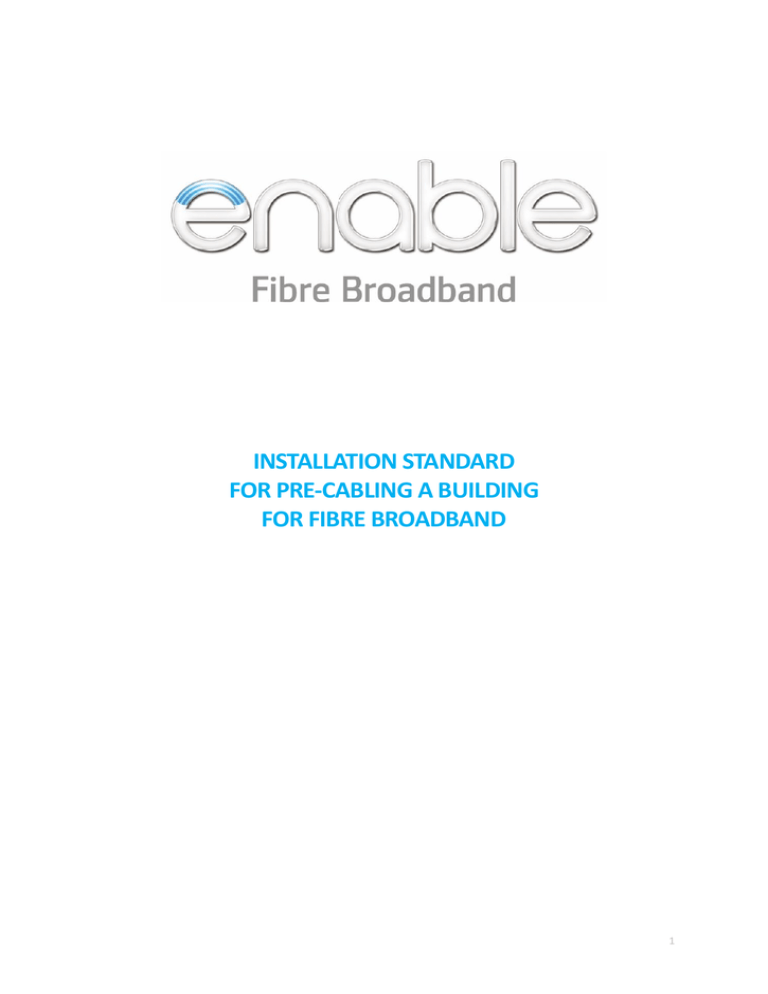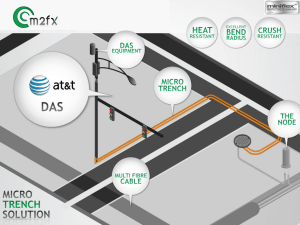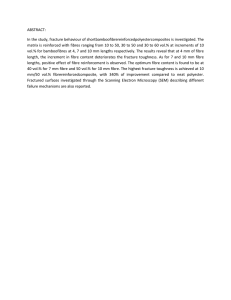installation standard for pre-cabling a building for fibre
advertisement

INSTALLATION STANDARD FOR PRE-CABLING A BUILDING FOR FIBRE BROADBAND 1 Table of Contents 1 GENERAL ............................................................................................................................. 3 1.1 Purpose ................................................................................................................................... 3 1.2 Reference Documentation ...................................................................................................... 3 1.3 Prerequisite ............................................................................................................................. 3 1.4 Defects .................................................................................................................................... 3 1.5 Deviations ............................................................................................................................... 3 1.6 Definitions ............................................................................................................................... 3 1.7 Minimum Bend Radius ............................................................................................................ 3 1.8 Glossary ................................................................................................................................... 4 1.9 Fibre Products Materials List .................................................................................................. 4 1.10 Scope ....................................................................................................................................... 5 1.10.1 MDU ................................................................................................................................. 5 1.10.2 SDU .................................................................................................................................. 6 2 INSTALLATION DETAIL .......................................................................................................... 7 2.1 General .................................................................................................................................... 7 2.1.1 Attaching LSZH Microduct ............................................................................................... 7 2.1.2 Running Microduct Vertically .......................................................................................... 8 2.1.3 Internal Surface Mounting ............................................................................................... 8 2.2 Cable installation..................................................................................................................... 9 2.2.1 Labelling ........................................................................................................................... 9 2.2.2 Drilling .............................................................................................................................. 9 2.2.3 Premise ............................................................................................................................ 9 2.2.4 Central Distribution Point (CDP) .................................................................................... 10 2.2.5 Home Distribution Box (Residential) or Communications Panel (Business) .................. 10 2.2.6 As-Built ........................................................................................................................... 11 2 1 1.1 GENERAL Purpose The purpose of this document is to provide a simple instruction that can be used to design or construct any premise to ensure it is fibre ready. It applies to new buildings and if an existing building is being retrofitted and internal access (stud work, risers etc.) is available. 1.2 Reference Documentation IS003 (Enable Services Standards – General) 1.3 Prerequisite Personnel must have suitable industry training and / or qualification before undertaking this work. 1.4 Defects Any defects caused must be rectified prior to closing up any walls, ceilings etc., otherwise it could result in the fibre path being unusable and surface mounted conduit being used. 1.5 Deviations Any need to deviate from this standard must be discussed with, and approved by, an appropriate ESL representative before continuing by calling 0800 4 FIBRE (0800 434 273) option 1. 1.6 Definitions Pre-fibred Low Smoke Zero Halogen (LSZH) Microduct This is a LSZH microduct and is for internal use only This can be pre-populated with 2 fibre product or empty Empty microduct can have up to 24 fibre cable blown in during a customer installation 1.7 Minimum Bend Radius This is the minimum radius one can bend a multiduct, microduct, or fibre cable. Having a lesser bend radius may damage the product, impede the installation of fibre, and may even introduce errors into the data Bitstream. Use the following table as a guide. The minimum bend radius for any product that is not covered in the table must be obtained before installation of that product. Product Microduct Size Minimum Bend Radius (mm) LSZH microduct (with or without fibre inserted) 1 x 5 mm 150 Bare fibre N/A 30 3 1.8 Glossary Abbreviation Terminology CDP Central Distribution Point CFP Common Fibre Point ESL Enable Services Ltd ETP External Termination Point LSZH Low Smoke Zero Halogen MDU Multi Dwelling Unit PVC Polyvinyl Chloride (Plastic Conduit) SDU Single Dwelling Unit Service Lead-in Tube or duct running from the premise boundary to the ETP U.V. Ultra Violet (solar Radiation) 1.9 Fibre Products Materials List Enable Part Number Product View LSZH Microduct Low Smoke Zero Halogen 3.5 / 5 mm microduct with inner silicon coating 10592 10689 LSZH Microduct pre-cabled with 2-fibre product Wall box, 1525, 24 splices, Indoor & Outdoor, 150 mm long by 250 mm wide by 130 mm deep This CDP is used for 3 to 12 Premises 10690 Wall box, 3030, 96 splices, Indoor & Outdoor, 300 mm long by 300 mm wide by 130 mm deep This CDP is used for 13 to 24 Premises 4 1.10 Scope This is an opportunity to install fibre during the build or retrofit-out stage to avoid disruption later, during the connection phase. For all types of premise, the intent is for pre-fibred LSZH tube to be installed from a common point to each premise within an MDU and from the Lead-in, meeting the premise, to the home media panel or communications panel in an SDU. This will simplify future installations. This document will cover 2 premise types, MDU and SDU. 1.10.1 MDU The installation of fibre in a low rise or high rise MDU from a Central Distribution Point (CDP) either in an internal common area, such as a comms room or basement garage, or mounted on an external wall, where no internal area is available. If the MDU is spread across multiple buildings, then each building will follow the same process. It is not advisable to install LSZH microduct between buildings. Each tenancy will be fed from a CDP located in an internal common area or an external wall, using a single, pre-fibred LSZH microduct. A low rise structure fed from an internal common area A low rise structure fed from an external common area A high rise structure fed from an internal common area (left) A high rise structure fed from an external common area (right) NOTE: If tenancy feeds are run externally, then they will need to be inside U.V. resistant conduit to protect the LSZH from the elements. 5 1.10.2 SDU The installation of fibre in a SDU from the External Termination Point (ETP) to the home media panel, ITP, in a residential premise or communication panel in a business premise. Standard SDU layout. If the Service lead-in has been laid directly into the premise without an ETP then the pre-wire shall run from the Service lead-in entry point to the Home Media Panel or Communications Panel 6 2 2.1 INSTALLATION DETAIL General The preferred product is a pre-fibred Low Smoke Zero Halogen (LSZH) microduct that can be easily run through internal cavities. The microduct has a thin wall which can kink very easily, therefore it must be handled accordingly with the number of bends kept as low as possible. You must also adhere to the minimum bend radius as discussed in Section 1.7. If the product is incorrectly installed it may adversely affect the delivery of the fibre, rendering the installation unusable. Ideally the product will be run inside walls where it will require little further protection. If run under floors, in ceilings, or vertical risers, it may need to be inside suitable conduit. The maximum distance for this product is 250 m. This may need to be taken into consideration when planning routes. 2.1.1 Attaching LSZH Microduct LSZH microduct is easily crushed. For this reason extreme must be taken when using cable ties to hold or attach it. If cable ties were applied too tightly, the microduct could be crushed, which would damage any fibre inside, or make it impossible to blow a fibre cable through it. Other methods for holding or attaching LSZH microduct both vertically and horizontally, are Velcro (19 mm or similar) and using insulation tape wrapped two or three times around. The microduct can even be attached to an existing cable. 7 2.1.2 Running Microduct Vertically The inner surface of LSZH microduct has a silicon coating to assist with fibre blowing. This is slippery and when microduct is run vertically, it can cause the fibre product to fall back down the microduct. It is imperative that the fibre product is secured at the top of the microduct run to ensure that it stays inside the microduct prior to running vertically. 2.1.3 Prior to running the pre-fibred microduct vertically, attach the fibre to the microduct using insulation tape This will stop the fibre cable sliding out of the microduct and ending up ending up in a pile at the bottom of the run Take care not to kink the fibre cable A variety of fixing products can be used, here are 2 examples in the diagram The LSZH should be supported every 300mm to prevent the weight causing the tube to lose shape or kink When running the product vertically, such as in a riser, extra care must be taken when managing bends at each floor as this is a prime area for kinks or crushing If mounted externally, then it must have U.V. rated protection, such as normal electrical PVC conduit. Galvanised conduit should be used in areas of risk below 2.4 m Internal Surface Mounting 8 2.2 Cable installation When running pre-fibred microducts through exposed walls (stud) then simple techniques can be used to ensure the integrity of the microduct remains: Drilling through the stud at a 45o angle Sweeping electrical bends to prevent damage 2.2.1 Labelling 2.2.2 The pre-fibred microducts must be labelled using a permanent labelling system on both ends This is especially critical at the CDP The drilling angle allows the pre-fibred microduct pass through without compromising the minimum bend radius Drilling 2.2.3 Premise At the final position within the premise a standard electrical back box can be used to house the prefibred microduct. The microduct is passed through the box and a 2m coil is required to ensure sufficient fibre is available for later use. 9 2.2.4 Central Distribution Point (CDP) In the common area the pre-fibred microducts should be managed to prevent damage, or installed into a 30/30 or 15/25 fibre management box. If a management box is used then microduct entry holes must be fitted with an appropriate gland to prevent vermin ingress. A minimum length of 2m is required to ensure sufficient fibre is available for later use. 2.2.5 Home Distribution Box (Residential) or Communications Panel (Business) In the Home Distribution Box or Communications Panel, the pre-fibred microduct should be managed to prevent damage by installing a standard electrical back box as seen in 2.2.3. 10 2.2.6 As-Built The as-built shall be updated to reflect the location of the fibre within each tenancy and common area. A straight forward numbering scheme can be used. Common Fibre Point Location: e.g. Corner wall Facing street End Fibre Point Location: End Fibre Point Number Common Fibre Point Number Unit 1 01 01 Unit 2 02 02 Unit 3 03 03 Unit 4 04 04 Unit 5 05 05 Unit 6 06 06 11



